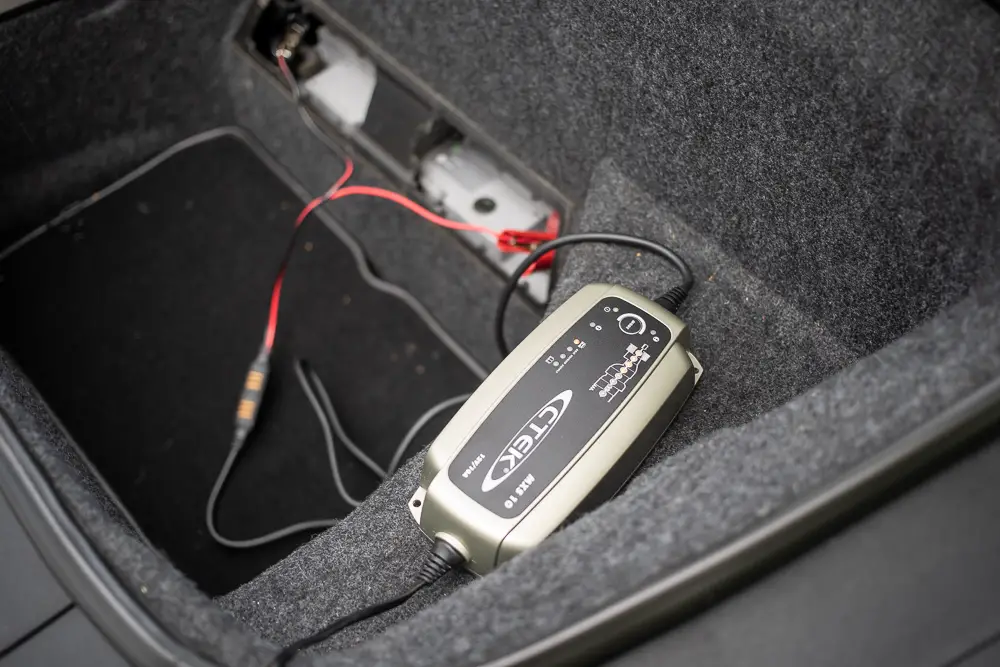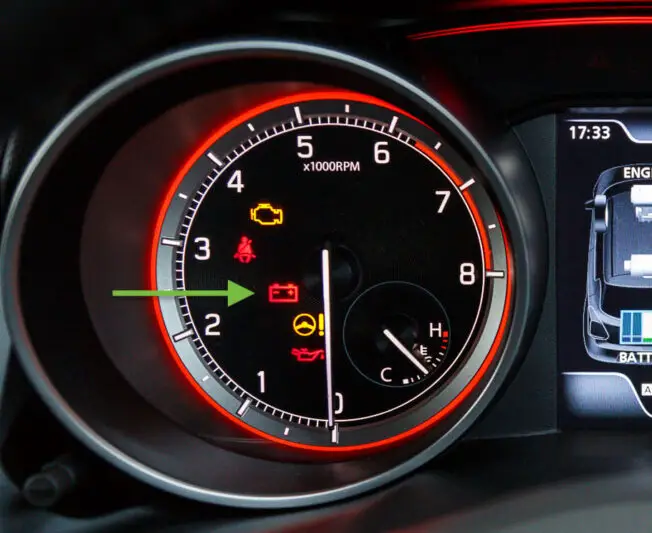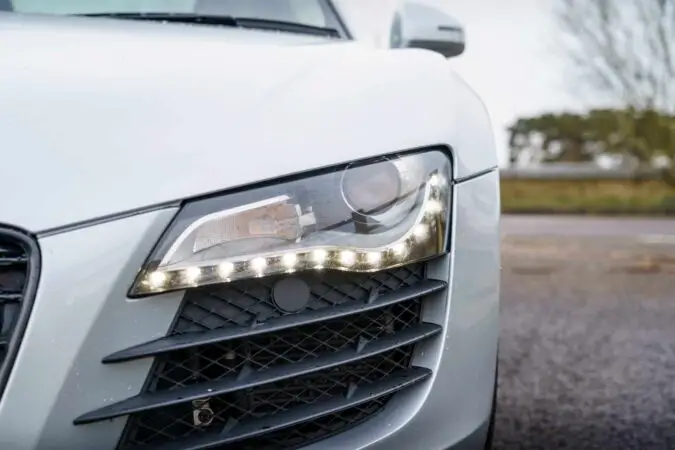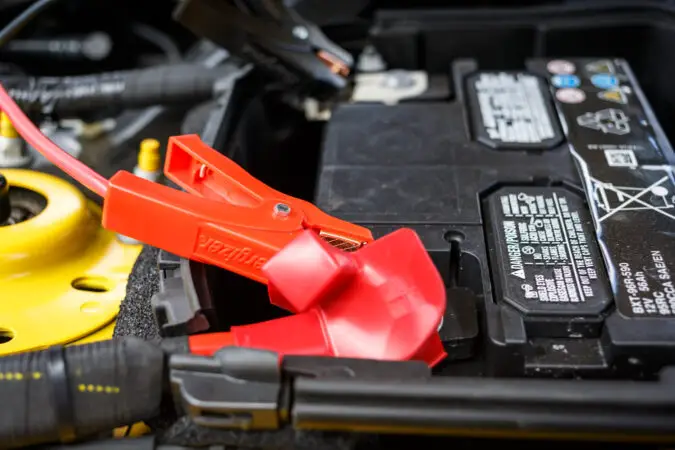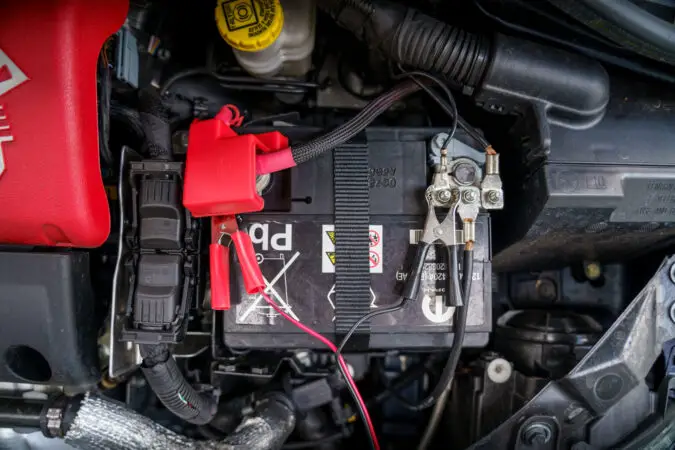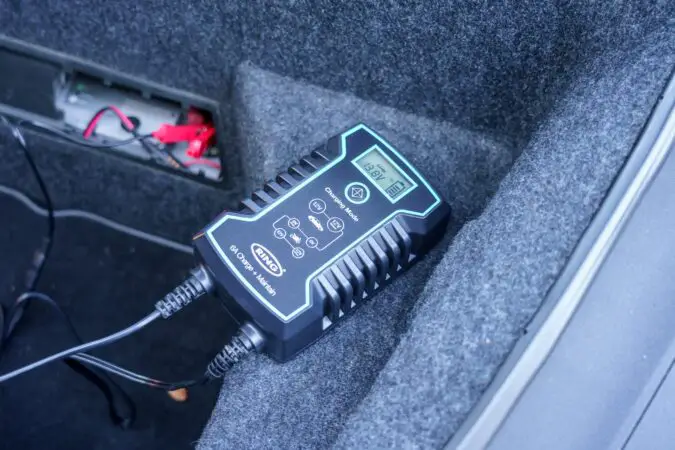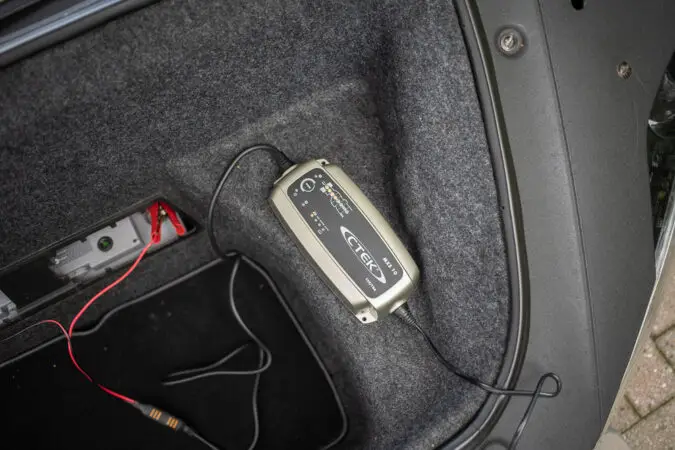We all know now, with the world being locked down, that driving isn’t something that’s as often done as it was before. Cars are meant to be driven around, and for their many parts to get sweaty every now and then. Letting it sit for a long time can have horrid unintended consequences, one of them being the car’s battery. While you’re Netflix-ing and chilling, the battery could very well die. This then prompts you to wonder, and ask how long does it take to charge a car battery?
Of course, you’d ask this question first, knowing that the alternative fixes require more elbow grease. You might not have someone readily available to jump-start your car. Nor, would you want to shell out and buy a whole new battery.
This is common enough of a problem under usual circumstances, and more so during the lockdown hibernation. So much so, that newspaper ads are actively being taken out to remind people to check their batteries once lockdown is over.
So, how long does it take to charge a car battery? Why did my battery go flat in the first place? What do I need to do to have my car running again? Loads of questions, and ones that we’ll answer one by one, step by step in our guide.
And worry not, as oftentimes your car battery going flat could be a very simple thing to fix. Most of what is required is a small investment of money, time, and energy. So, come along and have a read before making an appointment to buy a whole new battery.
- Causes of a dead battery
- Can you charge it?
- Types of chargers
- How long does it take?
- Prevention
- Conclusion
- FAQs
How To Know If Your Car Battery Is Dead
I know, you’re probably itching to know more about how long does it take to charge a car battery. But before we can go into discussing that, we’ll first need to understand more about the reasons behind your car’s battery going flat.
The battery, after all, is a key component in any car. In the context of internal combustion engine cars, the battery is the primary source of power for all your car’s electrics. This includes the actual starting of your car itself, sparking it into life.
A spark of electricity is needed to begin the combustion process, which makes your car go. Then, your car’s electrics need juice from the battery. This includes all your car’s lights, the windshield wipers, or the car’s internal computer brain with its many sensors.
Then, there are the little miscellaneous functions like running the cigarette lighter, or the car’s USB ports. This highlights then, the importance of what a battery does, and why it matters to keep it in good condition.
Ordinarily, your car’s battery is always kept charged while the car is running. Once the engine’s started, it will also power the alternator, which then charges the battery along. Naturally, lockdowns have meant that we couldn’t drive often enough to charge our car’s batteries.
But even when everything’s turned off, your car’s battery will indeed keep on draining. Because even while your car is asleep, the battery is needed to power functions such as your car’s alarm.
Before we get into discussing more on how long does it take to charge a car battery, here are some of the most common causes of flat batteries, even when your car is turned off.
1. Leaving The Lights On
As we’ve mentioned earlier, leaving your car’s lights to keep running while the engine is turned off can cause battery drain. This is most often a fairly innocent mistake. Maybe it’s in the middle of the day, and you’ve accidentally bumped onto the light switch.
Naturally, it would be hard to tell if the lights were even on, with a lot of sunlight outside. Or, you might’ve done this intentionally, wanting to keep the lights on to do something or see in the dark.
Say you’ve parked in a dark alley, and need some illumination to grab stuff from your car. Leaving the head-, and tail-lights on would make seeing things a lot easier. For brief periods of time, this is often fine.
Plus, your car’s alternators would recharge your battery the next time you take it for a drive. However, do this for an extended period, and it will drain your battery. Thankfully, most modern cars would warn you if you’ve left the lights on with the engine off.
2. Parasitic Drains Within The Car
This is also another extension from leaving your car’s lights on, which can cause your battery to run flat. ‘Parasitic’ drains or draws can be common enough in a lot of cars. We talked about how batteries will naturally drain over time, even when your car’s engine is turned off.
This is to keep the car’s electrical and electronic functions running, even when it’s sitting idle. Additionally, it could maintain your car’s alarm, keyless entry, internal clocks, and so on. Small drains like these are often normal.
What isn’t normal, is electrics turning on when they shouldn’t be. This is what is known as parasitic drains (which you can diagnose by learning what drains a car battery). They are minor electrical draws that don’t occur normally. Sometimes, this can be accidental.
For instance, accidentally leaving the glove box or trunk open or not fully closed would keep their lights on. Other times, this can be down to faulty electrics. Problems such as bad fuses, or bad wiring can cause things like your car’s interior lighting to come on when they shouldn’t.
3. Alternator Not Charging Your Car’s Battery
Another cause of a drained battery is down to a faulty alternator. We learned earlier that your car’s battery is always recharged while driving, or by keeping the engine running. This helps to drive the alternator, which is in essence, a generator that keeps your battery juiced up.
Think of this as needing to keep pedaling on your exercise bike to keep the display running. However, a car’s alternator can fail over time, either due to poor maintenance, or wear and tear.
This will mean that your battery can’t get recharged. This can happen while driving. You’ll either be met by your car suddenly switching off while driving or by waking up to a car that won’t even start.
There are some clear symptoms that you could look out for to know if your alternator is seeing signs of failure. The more common warning is through the ‘check engine light’ on your dash. Otherwise, notice any weird behaviors like difficulty starting, or a burning smell from the engine bay.
4. Taking Too Many Short Drives
We know now that you can recharge your car’s battery just by driving, or keeping the engine running. The alternator is a godsend, in this regard. However, know that the alternator will always require some time before it can fully charge up your car’s battery.
This will depend on your specific car and the condition of its battery. But in all, it certainly can’t top up your battery in an instant. In fact, it’s those short drives or engine start-ups that can be detrimental to your battery’s health.
You might think firing up your car’s engine for five minutes is enough. Or, maybe you’d take your car around your apartment’s parking garage in a circle, and think it’s sufficient to charge up the battery.
But in actuality, this is actually causing it to drain the battery even more. A car’s battery undergoes a lot of usage and strain while starting up. It needs to help spark the engine to life, while also turning on all your car’s electronics and electrics.
As such, the power draw is immense while your car is in the process of “booting up”. However, this electrical usage is negligible if you’re taking it out for a long drive, such as going to work.
This should be more than enough time for the alternator to work optimally, and charge your battery as needed. Turning your engine on, and then leaving the alternator to charge up for just a few minutes is not enough to top up the battery. Doing so is a net loss for your car’s overall battery capacity.
5. Excess Of Heat, Or Cold Temperatures
One thing we’ve learned in the era of electric cars is that temperature can have a big impact on a battery’s characteristics. This is owing to the chemical and material compounds inside the battery itself.
This can, for instance, cause the lead sulfate to crystallize. Something as simple as too much heat, or cold could affect the battery’s overall performance and capacity. This goes both ways with internal combustion cars, as well as electric cars.
Newer types or more well-maintained batteries should be able to resist extreme changes in temperature. However, older cars or batteries won’t share the same robustness. So, do take note of how you’re storing your car.
For example, keeping your car on the driveway while it’s snowing or cold outside could cause a more pronounced battery drain. Even worse, temperature changes can also make it so that the battery takes more time needed to charge.
6. Faulty, Loose, Or Corroded Battery Connectors
The battery is connected through the positive and negative terminals, which are then attached to the rest of the car. It functions both ways, sending electricity to the rest of your car, and also getting topped up from the alternator.
Therefore, it is important in making sure your battery’s connections are all well and good. But oftentimes, regular driving can cause wear and tear. For instance, all the vibrations and jostling around could knock the cables loose.
This would hamper both the electrical supply and also impacts how much your battery is charged up from the alternator. It could even cause long-term damage to other electrical parts of the car.
Maybe, those cables have become damaged, due to short-circuiting or excess heat from the engine. Alternatively, the terminals could become corroded over time, from being exposed to moisture. Corrosion on the terminals will impact the battery’s connections.
7. Worn Out, Or Weak Battery
A battery, just like many other parts of a car, would eventually wear out and need replacing. This is normal, and its lifespan will depend on how you’ve driven your car, and how you’ve maintained it.
The causes we’ve mentioned above could not only cause battery drain but also prematurely wear out your battery. Things such as letting your electrics keep running, poor charging from the alternator, or taking too many short drives can cause long-term wear.
Oftentimes, a car’s battery will easily last five years. However, you’re often recommended to replace it every three to four years of regular driving. Take good care of it, and it could happily run for more than that.
If the battery has gotten too old or weak, it will not be able to hold a full charge well. That could, for instance, cause it to drain much faster and die very quickly. Even the smallest parasitic drains, such as your car alarm running, could very well kill an old, or weak battery.
Can You Recharge A Car Battery
You may now be able to understand more as to why your car’s battery is dead. You’re content in knowing that it may or may not be your fault. But still, things need to be done, and you’re going to have to drive it eventually. But not so fast.
Before we need to know how long does it take to charge a car battery, you’ll first need to know if you can even charge it. Would a quick jump-start from another car’s battery suffice, or would you need to buy a completely new battery?
These are all valid questions, and knowing which approach to take first is important. People often think of jump-starting a car as the best possible solution. After all, it’s easy enough to do, provided you have the jumper cables and a fellow car owner willing to lend you their battery.
Or, consider a portable jump-starter. However, know that jump-starting a car can cause added strain to both the battery itself, and the alternator. This is since you’ll be needing to start up your car to recharge the battery.
Jump-Start vs Battery Charger vs Full Replacement
By doing so, the alternator has to work double-time. It’ll need to both help channel electricity to the dead battery, while also working for 15 minutes or so to continually recharge it.
Jump-starting a car will no doubt be worthwhile in an emergency, but it can lead to your alternator wearing out over time. The full cost of an alternator replacement (which could be trimmed a bit if you learn how to change an alternator) is far higher than needing to replace your battery. Therefore, jump-starting a battery should be something you save only for an emergency.
On the flip side, and as mentioned earlier, a car’s battery will need replacing at some point or another. Eventually, its usable capacity will decrease, and then become insufficient in maintaining the functions of the car.
There are some signs that you could tell if your battery is about to fail, and is in need of a replacement. For instance, your car might be slow to start, or “cough” as you’re turning the key. Your car might backfire, or you can notice the headlights running a bit dim.
If you notice any of those symptoms above, then your only choice would be needing to replace the entire battery. Finally, we get to a battery charger. This is the best way for maintaining your car battery’s charge, and without causing long-term damage.
This is less straining on your car than a jump-start and is certainly a far smaller investment than needing a full replacement. The only thing that it needs from you is a small expense in time, as it slowly charges up your car’s battery.
Best Car Battery Charger
The most natural question before asking how long does it take to charge a car battery, would be, “How do I even charge it in the first place?” Before we dive straight in, we’ll first need to know what kind of battery charger you’ll be needing.
This will, of course, be contingent on a number of variables. The most important of which is knowing what type of car battery you have. Typically, most cars have 12-volt lead-acid batteries, which should work easily with any type of charger.
You should also pay heed to the size of your battery’s capacity, and its condition before going any further into buying a battery charger. There are three common types of car battery chargers. There are linear, multi-stage, and trickle chargers.
Each has its uses, along with its respective benefits and downsides. For our guide here, we’ll be taking a look at them in a bit more detail. We’ll also see how they stack up, in regards to how long they each take for a full charge.
How Long Does It Take To Charge A Car Battery: Linear Battery Charger
This is the cheapest, and simplest way to charge up your car’s battery. Linear battery chargers can be found quite affordably, costing as little as $20 or $30 for most brands. They’re also very convenient to operate, as it requires you to plug them into any household wall outlet.
From there, it will charge up your car’s battery. However, its relatively low cost and ease do have some drawbacks. For one, linear battery chargers can only operate with low amperage.
What this means, is that it’ll take longer for your car’s battery to charge up to nominal levels. On average, you could be waiting for around 14 hours or more for a full charge, depending on the amperage.
Cheaper linear chargers operate around 2-3 amperes (amps per hour). Another disadvantage is that linear battery chargers are quite literally “linear” in their operation. They continually charge up your battery at a set amperage, and there’s no controller or additional setting to control that.
This results in a linear battery charger not knowing when to stop charging. Leaving it to overcharge your car’s battery could cause your already poorly battery to fail, or worse, explode.
As such, we only recommend linear battery chargers to those that have the patience to monitor their progress and ensure that your car’s battery isn’t being overcharged. Moreover, a linear battery charger is only suggested if you have the time to wait around 12 or so hours for a complete cycle.
How Long Does It Take To Charge A Car Battery: Multi-Stage Charger
Multi-stage chargers are far more complex, and featureful compared to a more simple linear battery charger. The big downside is that multi-stage battery chargers are far more expensive.
Most often, you’ll find them on sale for around $100. But for the most part, the drawbacks end there. As their name suggests, a multi-stage battery charger can operate in multiple different stages while charging.
This has led them to be called ‘smart’, or ‘intelligent’ chargers. What this means, is that multi-stage chargers recharge your car’s battery in bursts of electrical current. This is in contrast to a continuous stream of current being channeled, like the ones with a linear battery charger. The benefit here, is that charging like this is much better for your battery’s well-being in the long term, compared to a linear and continuous charge.
Moreover, multi-stage battery chargers offer to charge at much higher max amperages compared to the average linear charger. Among the more complex ones, a multi-stage charger can offer an amperage of up to 12 amperes (12 amp per hour).
This, in turn, could see your car’s battery charged up from nearly dead in as little as 5 or so minutes. At most, you’ll be waiting under 9 hours to fully charge a very large battery. Some of the more expensive ones even have displays, and gauges to let you control the amperage as needed.
How Long Does It Take To Charge A Car Battery: Trickle Charger
The last type of car battery charger is the trickle charger. It works very differently compared to both the linear and multi-stage battery chargers. Those two can at the very least charge up a car’s battery from dead, differentiated mostly by how long they’d take.
However, a trickle charger most often isn’t used for charging up a battery from dead. Instead, they are often used to prevent a car’s battery from being drained completely in the first place.
Trickle chargers operate at very low amperages, even compared to the cheaper linear chargers. As the name suggests, trickle chargers will only require tiny trickles of electrical current, often between 0.8 to 2 amperes. As such, it can take up to 2 days for a charge.
When your car is not being used for a long time, attaching it to a trickle charger would let the battery charge based on the amount that is needed. This is to ensure that the battery remains at its nominal capacity at all times. This is mostly used for storing cars and maintaining the battery at the same time.
How Long Does It Take To Charge A Car Battery
At this point, you might have a rough idea of how long it will take for your car’s battery to charge up using a battery charger. But, there are loads of different chargers on sale in the market today.
They can all be classed as per our examples earlier. So, how would I know more precisely how long does it take to charge a car battery from dead? To make things easier, we’re going to give you some scenarios.
Firstly, we need a baseline to make our maths a bit easier. Most cars will usually have a 12-volt lead-acid battery and a full capacity of around 60Ah (amperes). This is right around the average, although some cars might have 80 or larger ampere capacity batteries.
More commercial vehicles, such as vans or trucks almost always have bigger batteries. Now, we’ll consider the fact on average, car batteries can take in up to 12 ampere-per-hour.
This way, we have to key numbers – 60Ah total capacity, and an intake charge of up to 12 ampere-per-hour. We can then do simple maths depending on the amperage of your new battery charger.
For instance, a linear charger with an average amperage of 6A would require around 10 hours to charge up your car. Meanwhile, a trickle charger that sends around 1A might need a full 60 hours for a charge. Multi-stage chargers with a max output of 12A could have it done in around 5 hours.
So you need to find the Ah rating on your battery (possibly between 50Ah – 110Ah), then look at your charger and find the max charging rate (6 Amps as an example). Then divide the total capacity of the battery by the rating of your charger to find out how long it could take to charge.
Charing Formula
Total battery capacity/charging power = Time taken to charge
Charging Example
60 (Ah) / 6 amps (max amps per hours) = 10 Hours
How Long Does It Take To Charge A Car Battery: Prevention Tips
Let’s say at this stage, you’ve already charged up your car’s battery, and have taken your motor out for a drive. Surely, you’ll be relieved, but you might be curious to know how to prevent your car from draining its battery again.
There are, thankfully, a lot of ways you can make sure your car’s battery always stays full. For a start, make sure you’re attentive after having the engine turned off. Make sure all the lights and electronics are properly switched off before parking it in for the night.
The next step would be taking out your car for a drive every once in a while. Normally, a car’s battery can more or less last without driving it for around a week or two. However, we would definitely not recommend leaving any vehicle sitting idle for this long.
Try and take it out for a proper spin at the very least once a week. Understandably, this can be hard in our newly locked down lifestyles. However, do try to responsibly find a quiet place to roam around, if you can.
Even if it’s just driving it in circles around the neighborhood block, or around your apartment’s parking bay. And, be sure to take it out for a proper drive. Don’t just start up your car for five minutes, thinking it’s enough.
Have it driven for some reasonable distance, and at least for 15 minutes. If this isn’t an option, then consider safely disconnecting the battery from the car altogether to avoid those small current drains. Or, think of getting yourself a trickle charger.
Car Battery Facts:
- A 12-volt car battery contains six cells, each of which will contain 2.1 volts of power when fully charged, and is considered fully charged at 12.4 to 12.6 volts when the engine is off.
- A battery’s performance can drop significantly even with a small voltage drop, for example, a voltage of 12.1 means the battery is operating at only 50% of its total charge, while a voltage of 11.6 means the battery is almost completely discharged.
- To fully recharge a battery, you need a minimum of 1000 RPM, and it takes most vehicles about 30 minutes of driving at highway speeds to do so, though severely discharged batteries may take longer.
- An idle engine can still recharge the battery, but at a lower rate than driving because modern cars have additional electronics that use up power, meaning it may take several hours to recharge.
- An idle battery can go from fully charged to completely dead in under two months, especially if it’s older than three years or wasn’t fully charged the last time it was used.
- Taking several short driving trips in a row can quickly drain a battery, so it’s recommended to take a 30-minute drive on the highway at least once a week to fully recharge the battery.
- When selecting a battery charger, it must be compatible with the battery’s chemistry (e.g. lead-acid charger for a lead-acid battery) and its output voltage must match the battery’s voltage (e.g. 12-volt charger for a 12-volt car battery).
- There are three types of battery chargers: standard chargers, trickle chargers, and battery maintainers, each of which works differently.
- Car batteries typically last between three and five years and may need to be replaced if they struggle to start the engine or require frequent jump starts.
- Driving speed affects how fast the battery recharges, and it is recommended to drive at speeds of 55 MPH or higher to recharge the battery faster.
How Long Does It Take To Charge A Car Battery: In Conclusion…
That now concludes our guide on how long does it take to charge a car battery. We hope we’ve been of some assistance in letting you know how much time is needed to charge up a car’s battery.
We also hope you’re now more aware of what’s causing your car’s battery to keep discharging, and how to prevent it. It’s safe to say that, especially now within quarantine, this will be a common enough problem. Once lockdowns are lifted, we’ll be expecting more and more dead batteries.
Conclusively, the best way to prevent your car’s battery from going flat in the first place is just to drive it. In fact, never leave your car sitting still for any extended periods of time.
Everything in a car is best kept at its most optimal state while driving. Fluids need to swish, mechanicals need to lubricate, electricals need to run, and batteries need to charge.
FAQs On How Long Does It Take To Charge A Car Battery
If you’re still curious to learn more about how long does it take to charge a car battery, our FAQs here might help…
How Long Does It Take To Charge An Electric Car
The amount of time to charge an electric car varies wildly depending on a few key factors. Mainly, you’ll need to assess how large the battery is, the charge state of the battery (i.e. how much % of charge it has right now), and how fast can the charging station charge. Naturally, a larger battery, or a battery with a low charge rate, and a slow charging station will take more time to charge an electric car. For example, let’s say that your car has a 60kWh battery, is running nearly empty, and you want to charge it up back to 100%. If you plug it into a slower 7kW charging station, it would take you around 8.5 hours or so to go from empty to full. However, if you plug it into a faster 22kW charging station, you could accelerate this process to under 3 hours.
How Long Do Car Batteries Last
Generally speaking, a typical 12V lead-acid car battery will last around 3 to 4 years. Sometimes, you might even stretch it out to 5 years, if you take good care with trying to maintain its well-being. There are several reasons why a car battery would die over time. For the most part, a battery would die due to not being charged up properly. This is usually caused by a bad alternator. Similarly, a car battery that undergoes rapid discharging (likely because you’re running a lot of electronic accessories). Or, the battery is being overcharged constantly, which will cause it to fail prematurely. Speaking of, a battery that’s left unattended to and has undergone a deep discharge, like letting your car sit around for too long, will wear it out quicker, too.
How Many Volts Is A Car Battery
Although we refer to car batteries as 12V, their actual voltage never really stays at 12V, even by default. Specifically, a car’s lead-acid battery is typically rated at 12.6 volts. However, in select operations, the charge rate could go as high as 14.7 volts. This all depends on the situation. For example, when the car is running, the voltage should fluctuate anywhere between 13.7 to 14.7 volts at its peak. This high voltage figure is owed to the fact that the battery is constantly being charged up by the alternator. When your engine is turned off, the battery’s ‘resting voltage’ is around 12.6 volts. Although, in the real world, this might still fluctuate to anywhere between 12.2 to 12.8 volts. Anything below 12 volts is a sign that your battery is losing its charge.
How To Charge A Car Battery
If your car battery’s charge is too low, you could try using a battery charger to bring its charge rate back up. Using a battery charger is quite simple. First off, you have to make sure that the battery charger is turned off and isn’t plugged into the mains. Now, hook up the positive lead of the charger to the battery’s positive terminal. Then, repeat this process by hooking up the negative lead of the battery charger to the battery’s negative terminal. Once you’ve confirmed that they’re hooked up tight, plug your battery charger into the wall and turn it on. For most battery chargers, ensure that you start charging with the lowest rate of charge available as a setting on the charger. Finally, set a timer on the charger if you need to and let it top up the battery.
How Long Does An Electric Car Battery Last
One of the key sticking points with EV adoption is the lifespan of an electric car battery. Most car buyers have the misconception that an EV battery dies out after a few years and needs an expensive replacement soon thereafter. In reality, however, electric car batteries can last upwards of 10 or even 20 years with good care. In fact, many automakers already attach a lengthy warranty for the EV battery. Most of them offer similar terms – 5 to 8-year warranties on the battery, or usually around 100,000 miles. This has been getting even better in the past few years, as EVs and EV batteries have continued to evolve in reliability and technology. Although, replacing an EV battery is still expensive, which you may need to do if you’re owning an EV for the long term.

